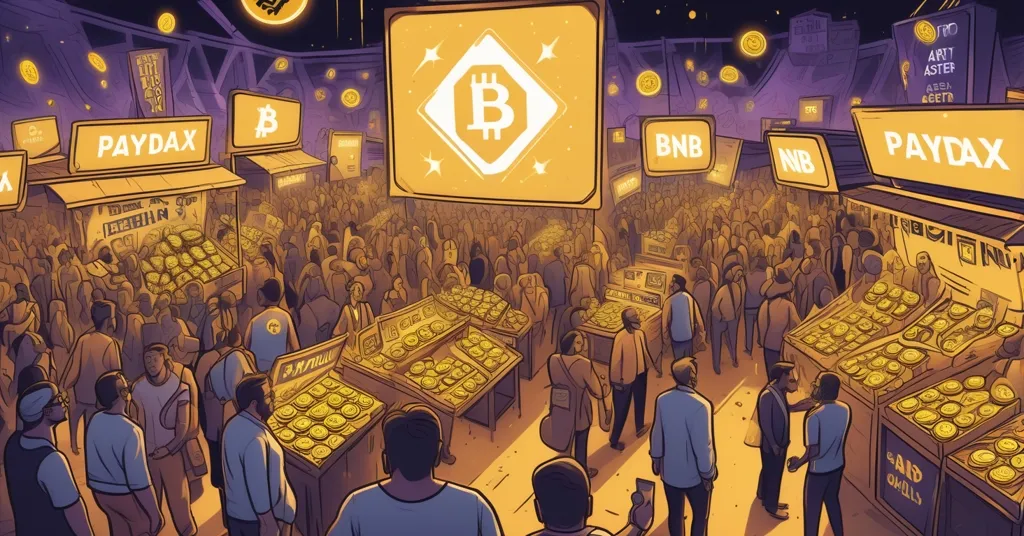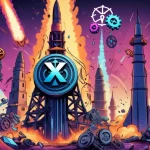PayDax Protocol at $0.015: Hype or Hazard Among Binance-Approved Altcoins?

Binance-Approved Altcoins Making Noise: Is PayDax Protocol at $0.015 Worth the Hype?
Binance, the titan of crypto exchanges, has given its nod to three altcoins that are sparking buzz across the market: Binance Coin (BNB), PayDax Protocol (PDP), and Aster (ASTER). With PayDax priced at a mere $0.015 in presale and promises of revolutionizing DeFi, the hype is loud—but is it justified? Let’s cut through the noise and dissect the potential, pitfalls, and broader implications of these projects with a no-nonsense lens.
- BNB: The bedrock of Binance’s ecosystem with utility and a deflationary twist.
- PayDax Protocol (PDP): A presale DeFi contender at $0.015, blending real-world assets with crypto lending.
- Aster (ASTER): A cross-chain DeFi project on BNB Chain with big numbers but less sizzle.
Why Binance’s Stamp Matters in Today’s Crypto Climate
Binance isn’t just an exchange; it’s a kingmaker in the crypto realm. With trading volumes dwarfing competitors, its approval can catapult altcoins into the spotlight, often signaling credibility to investors hungry for the next big thing. After the brutal bear market of 2022, the crypto space is clawing back with renewed optimism in 2023, and Binance’s endorsements—whether through Launchpad or Live AMAs—carry extra weight for projects vying to stand out in a sea of thousands. But let’s not forget, a nod from Binance doesn’t guarantee success; it’s just a ticket to the race, not a trophy.
BNB: The Safe Bet with Steady Power
Binance Coin (BNB) is the veteran in this lineup, a utility token that’s practically the lifeblood of the Binance ecosystem. Used to cut trading fees, power projects on Binance Launchpad, and fuel DeFi protocols on the BNB Chain (formerly Binance Smart Chain), BNB is a workhorse. Its quarterly token burn mechanism—where Binance destroys a portion of circulating supply based on trading volume—adds a deflationary edge, aiming to boost scarcity and, theoretically, value over time. Recent burns have torched millions of BNB, with over 2 million tokens removed in the latest round as of mid-2023, shrinking the total supply toward its 100 million cap.
BNB’s strength lies in its entrenched role. If Binance thrives, so does BNB. But with a market cap already in the tens of billions, its explosive growth days might be behind it. Compared to Bitcoin’s pure decentralization and store-of-value dominance, BNB feels like a centralized cog in Binance’s machine—useful, but not revolutionary. Still, for investors seeking stability over speculative moonshots, BNB remains a cornerstone, though it faces heat from rival exchange tokens like OKB (OKX) and KCS (KuCoin). Could regulatory scrutiny on centralized exchanges clip BNB’s wings? It’s a lingering risk, especially with global watchdogs circling platforms like Binance.
PayDax Protocol: Bold Vision or Dangerous Hype at $0.015?
Now, let’s tackle the shiny new toy: PayDax Protocol (PDP). At just $0.015 during its presale, this DeFi project has whipped up a frenzy, selling over 20% of its Stage 1 tokens in hours and raising north of $800,000. The pitch? Borrow stablecoins—cryptos pegged to assets like the US dollar—by locking up not just digital coins but tokenized real-world assets as collateral. We’re talking gold bars, fine art appraised by Sotheby’s, or luxury watches secured by Brinks. Add identity checks via Onfido, a Binance Live AMA hosted by Crypto Astronaut, and smart contracts audited by Assure-DeFi, and PayDax looks like it’s checking all the right boxes for credibility. Hell, even their team, including the CTO and CMO, is fully doxxed—public identities in a space rife with shadowy devs. If you’re curious about the buzz around this token, check out more details on Binance-approved altcoins making waves.
Tokenomics-wise, PayDax aims to reward holders: 40% of revenue goes to stakers (those who lock up tokens for returns), 25% to the protocol treasury, 20% to development, and 15% to protocol-owned liquidity (funds the project holds to keep trading smooth on exchanges). Their roadmap is a tech nerd’s dream—AI risk engines to assess collateral, off-chain data integration, multi-asset pools, and institutional lending pools down the line. Some wild-eyed analysts are tossing out market cap predictions of $150 million (10x returns), $750 million (50x), or even $1.5 billion (a jaw-dropping 166x). A $1,000 bet at presale could, in fantasy land, become $166,000. They’re even offering an 80% buying bonus with code “PD80BONUS” to lure early birds.
But let’s slam the brakes. These projections are pure guesswork, not gospel. Presale altcoins are the Wild West—high risk, high reward, often just high regret. The DeFi graveyard is packed with flops like SafeMoon or BitConnect, where hype outran execution, leaving investors burned. PayDax’s concept of tokenizing real-world assets—turning physical items into digital tokens on a blockchain—could unlock liquidity for owners reluctant to sell heirlooms. Imagine borrowing against a $100,000 painting without parting with it. Neat idea, but the hurdles are steep. How do you guarantee the physical asset’s safety if Brinks screws up? What if legal disputes over ownership clog the courts? And don’t even start on hacks—tokenization platforms are juicy targets.
Then there’s the regulatory minefield. DeFi lending tied to real-world assets treads dangerously close to traditional finance, and agencies like the SEC in the US or the EU’s upcoming MiCA framework could slap down hard if they smell unlicensed banking. PayDax’s reliance on third parties like Sotheby’s for validation also raises questions—partnerships sound sexy, but what if costs spiral or a partner bails? For all its innovation, PayDax is a gamble, plain and simple. Bitcoin maximalists like me squint at this complexity—BTC’s beauty is its simplicity and security, not convoluted lending schemes. Still, I’ll admit, if PayDax pulls this off, it could carve a niche Bitcoin was never meant to fill.
Aster: Cross-Chain Contender or Just Another Runner?
Rounding out the trio is Aster (ASTER), a Binance-approved altcoin launched in mid-September on the BNB Chain. Its focus? Cross-chain DeFi, meaning it helps transactions and services flow between different blockchains—think Ethereum to Solana to BNB Chain. Interoperability is the holy grail as crypto moves past siloed networks, and Aster’s numbers are eye-popping: over $1 trillion in total trading volume, with $82 billion in the last 24 hours. That’s not pocket change. Yet, in the crowded race of Layer 1 (base blockchains like Ethereum) and Layer 2 (scaling solutions built atop them) projects, Aster struggles to stand out.
Unlike PayDax’s unique collateral hook or BNB’s utility dominance, Aster feels like just another contender panting for attention. It competes with heavyweights like Polkadot and Cosmos, both pushing cross-chain tech with bigger communities and deeper pockets. What’s Aster’s edge? Details are thin—there’s little on which specific chains it bridges best or standout features beyond raw volume. For investors, it’s less undervalued than PayDax’s presale pricing and lacks BNB’s proven track record. Sure, cross-chain tech is critical for DeFi’s future, breaking down walls between ecosystems, but Aster’s path to the podium isn’t obvious. Could it be a sleeper hit? Maybe, but right now, it’s overshadowed.
Market Context: DeFi Dreams and Regulatory Nightmares
Zooming out, these Binance-backed altcoins reflect a crypto market itching for innovation after years of ups and downs. DeFi’s rise—decentralized finance that cuts out middlemen like banks—continues to captivate, with tokenized real-world assets (PayDax’s angle) and cross-chain interoperability (Aster’s play) as hot trends in 2023. Binance’s influence here mirrors past successes; their Launchpad has birthed winners like Polygon (MATIC), often turning small bets into big paydays. But history also warns us: for every Polygon, there’s a rug pull or a fizzled presale. PayDax, especially, walks a tightrope—bridging TradFi and DeFi sounds revolutionary, but governments aren’t exactly rolling out welcome mats.
Regulatory heat is the gorilla in the room. The SEC has already cracked down on DeFi projects for “unregistered securities,” and tokenized assets tied to physical goods could draw even sharper scrutiny as unlicensed lending. Europe’s MiCA rules, set to roll out in 2024, aim to tame crypto’s Wild West, potentially choking projects like PayDax if compliance costs soar. Even BNB isn’t immune—Binance has faced fines and bans in multiple jurisdictions. Aster’s cross-chain ambitions might dodge some of this by staying purely digital, but nothing’s certain. Investors betting on these altcoins aren’t just gambling on tech; they’re rolling dice on policy whims.
Bitcoin’s Shadow: Maximalism Meets Altcoin Niches
As a Bitcoin maximalist, I’ve got to throw in my two sats. Bitcoin remains the gold standard—decentralized, censorship-resistant, a middle finger to the status quo. BNB’s centralized reliance on Binance, PayDax’s untested complexity, and Aster’s crowded field pale next to BTC’s simplicity as a store of value. Why mess with altcoin roulette when Bitcoin’s proven its staying power? Yet, I’ll concede, not every problem needs a BTC hammer. PayDax’s lending model, if it works, tackles liquidity in ways Bitcoin shouldn’t. Aster’s cross-chain push could glue fragmented blockchains together, a utility BTC doesn’t aim for. Altcoins have their place—narrow, niche, often overhyped, but occasionally vital.
Key Takeaways and Questions to Ponder
- Why is Binance Coin (BNB) a solid choice among these altcoins?
BNB’s tight integration into Binance’s ecosystem—cutting fees, powering DeFi on BNB Chain—and its token burn strategy make it a stable pick over speculative newcomers. - Does PayDax Protocol’s $0.015 presale price scream opportunity or danger?
Its DeFi lending with tokenized real-world assets is a fresh idea, but presales are notorious traps—166x return predictions are fantasies, and execution or regulatory risks could kill it. - Where does Aster stand in the DeFi race compared to BNB and PayDax?
Aster’s cross-chain focus and trillion-dollar volume impress, but it lacks PayDax’s novel approach or BNB’s utility, leaving it as a less compelling bet in a packed field. - Can tokenized assets in DeFi, like PayDax’s model, reshape finance?
Borrowing against art or gold without selling could unlock huge liquidity, but security flaws, legal battles, and scalability issues might stop it from going mainstream. - What’s the ugliest risk with presale hypes like PayDax?
FOMO fuels irrational bets—many presales collapse from poor delivery or outright scams, and investors can lose every penny if the team vanishes or fails. - How does Bitcoin stack up against these altcoin experiments?
Bitcoin’s unmatched decentralization and security tower over altcoin complexity, though projects like PayDax and Aster might fill specific gaps BTC isn’t built for.
Binance’s backing of BNB, PayDax, and Aster spotlights their potential to nudge crypto forward, but potential ain’t a promise. BNB offers a reliable anchor tied to Binance’s reign, Aster hints at a connected DeFi future, and PayDax—if it doesn’t implode—could redefine lending with real-world assets. Yet, the crypto jungle doesn’t care for hype or good intentions. Regulatory storms, execution flops, and market whims can sink even the brightest ideas. For every step toward decentralization and disruption we cheer as accelerationists, there’s a scam or setback waiting to bite. If you’re tossing money at these, especially presales like PayDax, keep it to what you can afford to burn. Research hard, stay skeptical, and remember: Bitcoin’s still king, but the court jesters might just steal a scene or two.



